 Depoforez is a method that allows one of the primary tasks facing a dentist to be solved - to create a sterile environment in the canal channels to be sealed.
Depoforez is a method that allows one of the primary tasks facing a dentist to be solved - to create a sterile environment in the canal channels to be sealed.
Measures taken before the discovery of the method were not effective enough. After all, it is not possible to reliably "etch" the whole network of a set of branching tubules of negligible small diameter, in which canals of a chronic infection may be preserved.
The decision prompted. .. copper. The magic properties of copper sulfate in the cultivation of cultivated plants are well known. Destroying the lower forms of life - fungi and mold, it promotes the growth and development of higher life invariably, because the very name "vitriol" means: for the growth of the dump, that is, heapy, thick.
Similarly, copper promotes active growth and regeneration of bone tissue, which leads to a rapid and complete restoration of the function of the channels exposed to coarse heat and vibration. A pickling with solutions of copper salts of their entire network to the level of absolute sterility allows you to completely forget about the problem of infection in the cavity of the tooth.
Depotection is the disinfection of the cavity of the tooth by electrochemical exposure. The solution introduced into the cavity of the tooth under a specially designed 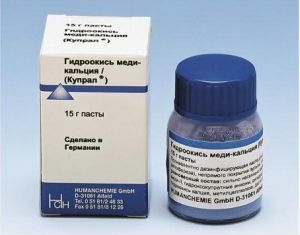 pressure penetrates the entire network of channels and creates salt depots in them.
pressure penetrates the entire network of channels and creates salt depots in them.
Being guided in a weak electric field and moving to the negative pole of the device, the positively charged ions released from the solution of copper salt( copper hydroxide) settle not only on the walls of the drilled channel, but also on the internal surfaces of all the others. There is galvanic copper plating of their walls.
That is accompanied by the death of even the most deeply infiltrated infection.
Contents
- Scope and contraindications
- Stage after stage
- Errors, complications and doubts. ..
- Used toolkit
- Service demand and its cost
Scope and contraindications
The procedure is recommended in the case of channels:
- curved and difficult to pass;
- previously sealed, without the possibility of their rasplombirovaniya;
- with the presence of apical cyst;
- with the remains of decomposing( gangrenous) or dead tissue.
When the fragment of the pulp extractor breaks off, both depophoresis facilitates its extraction, and( if this is not possible) preserves it in the dental canal without an inflammatory reaction.
All this gives the method undeniable advantages over other methods of treatment and processing of dental canals, because: 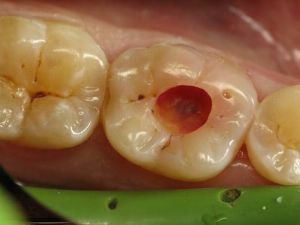
- provides the stability of the dental root in the mechanical plan;
- prevents reinfection of the apical delta of the dental root;
- eliminates the need for resection of the apex of the root;
- does not give the patient painful sensations in view of simplicity and painlessness during the procedure.
The category of persons to whom depophoresis is contraindicated is very few:
- pregnant;
- suffering from exacerbation of periodontitis;
- patients with the presence in the dental canal of a silver pin.
This includes persons with excessive sensitivity to copper compounds.
Stage after stage
Before the direct procedure is performed, the state of the tooth roots is evaluated by X-ray diffraction, manual pulp extraction is performed.
Further, the dentist operates according to the following algorithm:
- Anesthesia is adequate( local, less common).
- Introduction to the tooth canal( to a depth of 5 to 8 mm) of the cathode electrode connected to the negative pole of the device. The electrode of the aggregate is positive - the anode is located on the inner surface of the cheek, but without the possibility of touching the teeth.
- Simultaneously with the supply of a solution of copper-calcium hydroxide to the tooth channel, an electric field with a current strength of 2 mA for a duration of 5 to 10 minutes is created to allow ions to move. In the process of motion, the ions penetrate all the canalic branches of the dental root, leading to their complete disinfection.
- At the end of the session, both electrodes are extracted from the oral cavity, and the tooth channel is thoroughly washed with 10% calcium hydroxide suspension or distilled water.
- The tooth cavity is filled with the same chemical agent - copper-calcium hydroxide paste-like consistency.
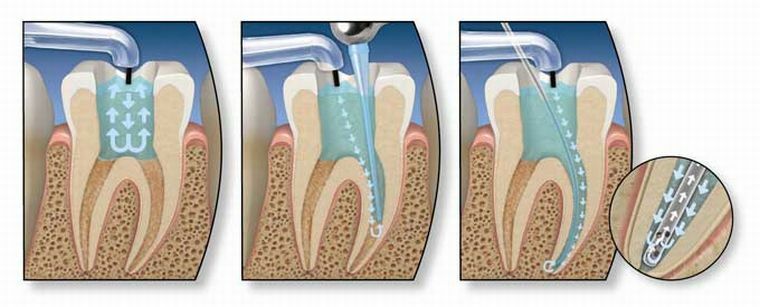
Before the final filling of the tooth, the session is repeated twice, with an interval of 7 to 14 days( usually 7 days), the total duration of treatment with depophoresis is about 1 month.
Errors, complications and doubts. ..
Despite the use of depophoresis in the Russian Federation since 1990, a number of authors directly point out both the possibility of consequences and complications in the use of the technique, and the limitations of its capabilities.
Thus, prolonged contact with hydroxides, slowly dissolving collagen of dentin, leads to a weakening of the dentin strength of the dental root. And the motion of ions in an electric field is possible only under condition of absence of both intermediate and external cement on the outer surface of the tooth root, otherwise the technique is not justified( cement substance is an insulator-insulator).
The effect of copper, known for its toxicity, deposited in dental tissues, on the vital activity of the organism, has not been fully investigated either.
The consequences of using depophoresis include the ability to stain teeth, especially noticeable on the facade - front teeth( due to the high copper content of the composition used).
If the teeth are not subsequently worn with artificial crowns, you should change the recipe used, including 10% copper hydroxide, and 90% should make a highly dispersible calcium hydroxide.
Used toolkit
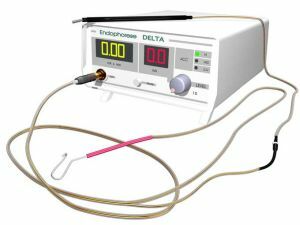 The author of the method by Professor Knappswast guarantees a high, close to 100% success of the application of the technique only on the original Original II machine, produced by the German company Humanchemie. The author does not bear responsibility for the results of treatment with analogous devices used by dentists in his own practice.
The author of the method by Professor Knappswast guarantees a high, close to 100% success of the application of the technique only on the original Original II machine, produced by the German company Humanchemie. The author does not bear responsibility for the results of treatment with analogous devices used by dentists in his own practice.
The device of the manufacturer( in the author's version) allows you to accurately dose both the duration of the session and the fine-tuning of the electric field with the necessary current in it.
When using the device for depophoresis, it is necessary to monitor the condition of the mucous membrane of the lips at the point of contact with the electrode, avoiding overheating of its tissues, and direct contact of the electrode with the metal of the crowns in the patient's mouth is also unacceptable.
The Humanchemie is supplied with its own ingredients for various process steps:
- for the direct coating of pulp, a highly dispersed fraction of calcium hydroxide of pasty consistency and the Copper-hydroxide of copper-calcium;
- methyl cellulose is necessary for temporary( between sessions) isolation of the dental roots;
- distilled water is used for washing the channels of the tooth being treated;
- in the process of treatment and final filling of canals, Atacetam powder - an alkaline cement containing a high percentage of copper is used, there is also a special liquid in the set for its hardening.
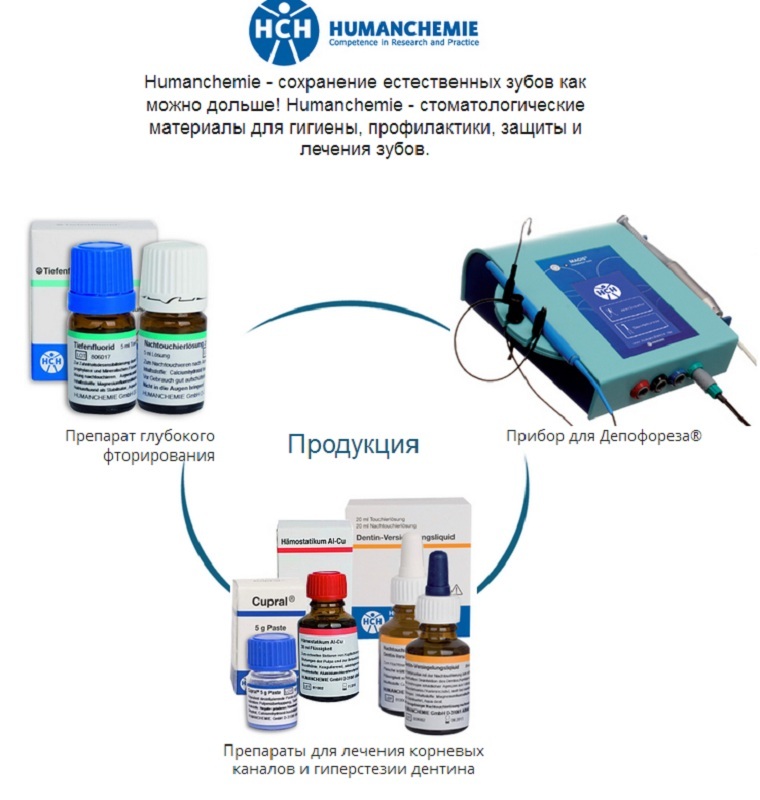
Humanchemie equipment for depophoresis
In addition to Humanchemie, the Russian Federation has also developed domestic equipment with an even wider range of applications:
- So, the use of endodontic diagnostic tool EndoST allows applying it not only to achieve sterility of the roots( anodic sterilization), but also for electrophoresis in osteolysis, periodontitis, pulpitis, for the treatment of the root cyst.
- ASK 2.1 is a device for carrying out both depophoresis and iontophoresis and electrophoresis, as well as for solving the problem of obturation of the root canals.
- Portable AOK 1.0 MODIS with integrated graphic indicator besides depot, electro- and iontophoresis, fluorides the enamel.
- Special attention deserves ASK 1.1 Endo-suite , which is a worthy analogue of an expensive German device, excellent for overcoming the problems associated with dental canals.
Well proven and domestic analogues of compositions for depophoresis: Kupratin and Kuprodent.
Service demand and cost
Depophoresis in Russia is gaining popularity, which is confirmed by the patients' reviews and a sharp increase in the cost of treatment in recent years.
I have been given sessions of electrotherapy with copper hydroxide due to the breakage of the pin in the canal of the tooth. During the first day I felt so bad that I did not know what to do.
In addition to burning on the tongue on the side of the treated tooth and poisonous taste, spasms in the throat appeared in the mouth, followed by nausea with weakness, abdominal pains and intense headache.
The treating dentist said: treatment has nothing to do with it. But why, then, did such a condition, if it did not hurt, not drink medicines, was not burdened with harmful habits? Later it became clear: I suffer from hypersensitivity to copper. Will have to be treated in a traditional way.
Anastasia, 12 February 2007
With a depophoresis, the growing pain in the tooth "brought".Saw a pill, went to the service - she was afraid to be treated. It got to the point that they took us to the ambulance from the service.
It was found out: in the "securely" sealed tooth began pulpitis. Roentgen revealed a narrowing of the root canal, and the doctor in charge suggested that the channel had not been completely passed during the past filling.
There is still one more treatment session, no pain, well-being, the only annoyance - I can not get used to the copper taste in my mouth. But compared to the experienced toothache is a trifle.
Nina, March 27, 2016
Price depophoresis in dental clinics in Moscow ranges from 260-300 rubles per one treatment of single-channel tooth to 3000 rubles for a full course of cleaning one channel.
